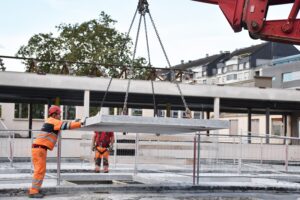How to reduce the carbon footprint of new floor systems? Researchers from the University of Luxembourg and EPFL have been able to reduce it by 80% which represents an enormous potential for the construction sector. Their findings have been published in the renowned Journal of Cleaner Production.
The study explores an original idea to reduce the detrimental environmental impacts of floor by reusing saw-cut reinforced concrete pieces salvaged from soon-to-be demolished structures. The study demonstrates how discarded cast-in-place reinforced concrete floors can be cut and reused to build new low-carbon, little-extractive, load-bearing building floors.
Prof. Numa Bertola from the University of Luxembourg together with Dr. Célia Küpfer and Prof. Corentin Fivet from EPFL propose two new floor design solutions for housing and office buildings that valorise frequently discarded construction components (reinforced concrete slabs and steel profiles), combining construction technologies already used by the industry. A parametric life cycle assessment model with 20,000 simulations shows drastic embodied carbon cuts compared to new flat concrete slabs, with solutions as low as 5 kgCO2e/m2, probably a record for building slabs.
Overall, this study sets up a new benchmark for innovative floor systems with minimum environmental impacts and calls for considering soon-to-be demolished reinforce concrete structures as mines of valuable construction components.
Publication “Reuse of cut concrete slabs in new buildings for circular ultra-low-carbon floor designs“, Journal of Cleaner Production, March 2024
